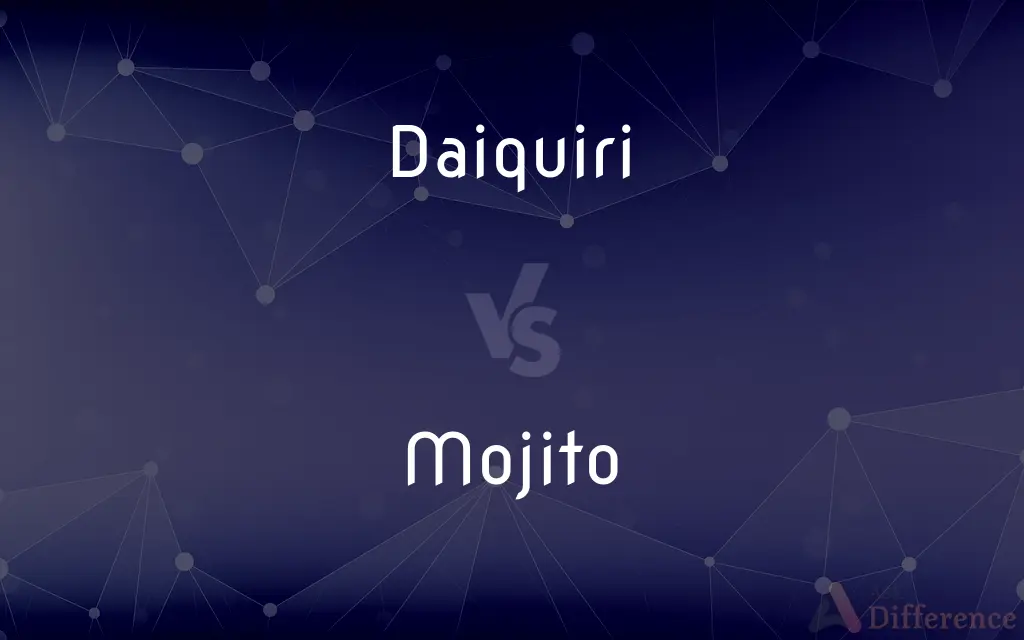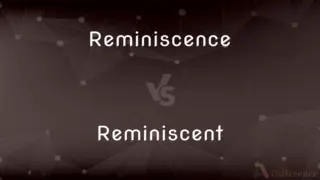Daiquiri vs. Mojito — What's the Difference?
Edited by Tayyaba Rehman — By Fiza Rafique — Updated on November 3, 2023
Daiquiri is a cocktail made with rum, lime juice, and sugar. Mojito is a cocktail made with rum, mint, lime, sugar, and soda water.

Difference Between Daiquiri and Mojito
Table of Contents
ADVERTISEMENT
Key Differences
Daiquiri is a cocktail that focuses on the harmony between rum, lime, and sugar. Mojito also uses rum and lime but introduces mint and soda water for a refreshing twist. The Daiquiri is often served shaken with ice and strained, providing a smooth, clean sip, while the Mojito is muddled and served with ice, creating a more textured and effervescent experience.
A Daiquiri is traditionally a simple blend, known for its straightforward tartness and rum-forward flavor. In contrast, a Mojito is a more complex drink, with the mint adding a fresh, aromatic quality. The Mojito's use of soda water also lightens the drink, making it particularly refreshing on a hot day.
The serving style of a Daiquiri often varies from a classic stemmed cocktail glass to being served frozen, blended with ice. Mojitos are typically served in a highball glass, topped with soda and garnished with a sprig of mint. Both the Daiquiri and Mojito may be garnished with lime, but the presentation and texture of the drinks are distinctly different.
When considering the origins, the Daiquiri is believed to have been invented in Cuba by an American mining engineer, while the Mojito also traces its roots back to Cuba, with claims of it being a favorite of Ernest Hemingway. The Daiquiri’s simplicity gives it a timeless elegance, while the Mojito’s refreshing character makes it a perennial summer favorite.
Daiquiris can come in various flavors with fruit purées, but they maintain their characteristic sharpness. Mojitos have variations that may include different fruits as well, yet they retain the essential mint and soda water components that give them their signature freshness.
ADVERTISEMENT
Comparison Chart
Main Ingredients
Rum, lime juice, sugar.
Rum, mint, lime juice, sugar, soda water.
Presentation
Served shaken and strained.
Served muddled with ice, not strained.
Texture
Smooth and crisp.
Textured with muddled mint leaves.
Flavor
Tart and sweet.
Refreshing, minty, with sweetness.
Glass Type
Cocktail glass or served frozen.
Highball glass.
Compare with Definitions
Daiquiri
A tart rum-based cocktail.
She sipped her daiquiri while watching the sunset.
Mojito
A minty rum cocktail with soda.
The mojito's minty flavor was the perfect remedy for the summer heat.
Daiquiri
Contains lime juice and sugar.
The bartender mixed a perfect balance of rum and lime for the daiquiri.
Mojito
Features muddled mint leaves.
He muddled the mint carefully to release its flavor into the mojito.
Daiquiri
Originated in Cuba.
On their trip to Havana, they enjoyed an authentic Cuban daiquiri.
Mojito
Served in a highball glass.
The bartender added ice to the highball glass for the mojito.
Daiquiri
Often served shaken with ice.
He ordered a daiquiri, preferring his cocktails shaken, not stirred.
Mojito
A Cuban classic cocktail.
Their Havana night was complete after a round of mojitos.
Daiquiri
Daiquiri (; Spanish: daiquirí [dajkiˈɾi]) is a family of cocktails whose main ingredients are rum, citrus juice (typically lime juice), and sugar or other sweetener. The daiquiri is one of the six basic drinks listed in David A. Embury's classic The Fine Art of Mixing Drinks, which also lists some variations.
Mojito
Enhanced with soda water.
She topped the mojito with soda for a fizzy finish.
Daiquiri
A cocktail containing rum and lime juice.
Mojito
Mojito (; Spanish: [moˈxito]) is a traditional Cuban highball. The cocktail often consists of five ingredients: white rum, sugar (traditionally sugar cane juice), lime juice, soda water, and Spearmint.
Daiquiri
An iced cocktail of rum, lime or lemon juice, and sugar.
Mojito
A cocktail made of rum, sugar, lime juice, crushed mint leaves, soda water, and shaved ice.
Daiquiri
A cocktail of rum, lemon or lime juice and sugar, sometimes with fruit added.
Mojito
A Cuban cocktail, generally made from rum, lime, sugar, mint, etc.
Daiquiri
An alcoholic beverage containing rum and lime or lemon juice, usually mixed with a fruit juice or fruit extract and often blended with crushed ice; as, a strawberry daiquiri.
Daiquiri
A cocktail made with rum and lime or lemon juice
Daiquiri
Can be flavored with fruits.
The strawberry daiquiri was refreshingly sweet.
Common Curiosities
How is a Daiquiri served?
A Daiquiri is typically served shaken with ice and strained into a glass.
Can Daiquiris be flavored?
Yes, Daiquiris can be made with various fruit purées for different flavors.
Are Daiquiris sweet?
Daiquiris have a sweet and tart flavor profile from the sugar and lime.
What is a Mojito?
A Mojito is a cocktail made with rum, mint, lime juice, sugar, and soda water.
Is a Mojito a strong drink?
A Mojito is generally considered a lighter cocktail due to the soda water.
What is a Daiquiri?
A Daiquiri is a cocktail made with rum, lime juice, and sugar.
Are Mojitos always minty?
Yes, the defining characteristic of a Mojito is its mint flavor.
What type of rum should be used for a Mojito?
A light rum is also preferred for Mojitos to complement the fresh flavors.
What makes a Mojito unique?
The Mojito is unique for its use of fresh mint and soda water.
What type of rum should be used for a Daiquiri?
A light rum is typically used for Daiquiris.
Are Mojitos sweet or sour?
Mojitos are a balance of sweet from the sugar and sour from the lime.
What occasion is a Mojito best for?
A Mojito is ideal for summer parties and casual outdoor events.
Can you make a non-alcoholic version of these cocktails?
Yes, you can create "mocktail" versions of both the Daiquiri and the Mojito without rum.
Is a Daiquiri a strong drink?
The strength of a Daiquiri depends on the ratio of rum to other ingredients.
What occasion is a Daiquiri best for?
A Daiquiri is great for a formal occasion or a casual get-together.
Share Your Discovery

Previous Comparison
Reminiscence vs. Reminiscent
Next Comparison
Client vs. ClienteleAuthor Spotlight
Written by
Fiza RafiqueFiza Rafique is a skilled content writer at AskDifference.com, where she meticulously refines and enhances written pieces. Drawing from her vast editorial expertise, Fiza ensures clarity, accuracy, and precision in every article. Passionate about language, she continually seeks to elevate the quality of content for readers worldwide.
Edited by
Tayyaba RehmanTayyaba Rehman is a distinguished writer, currently serving as a primary contributor to askdifference.com. As a researcher in semantics and etymology, Tayyaba's passion for the complexity of languages and their distinctions has found a perfect home on the platform. Tayyaba delves into the intricacies of language, distinguishing between commonly confused words and phrases, thereby providing clarity for readers worldwide.















































